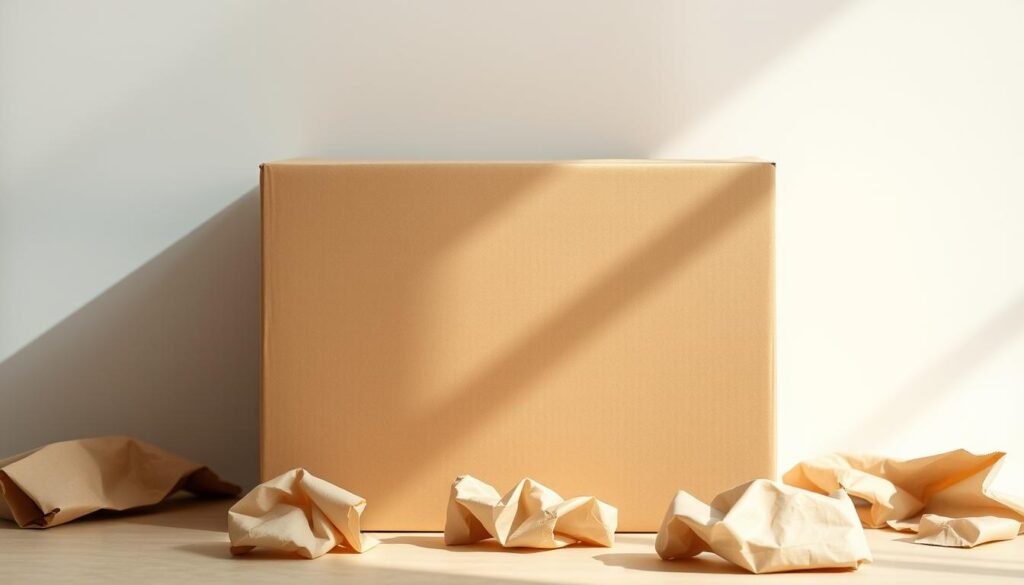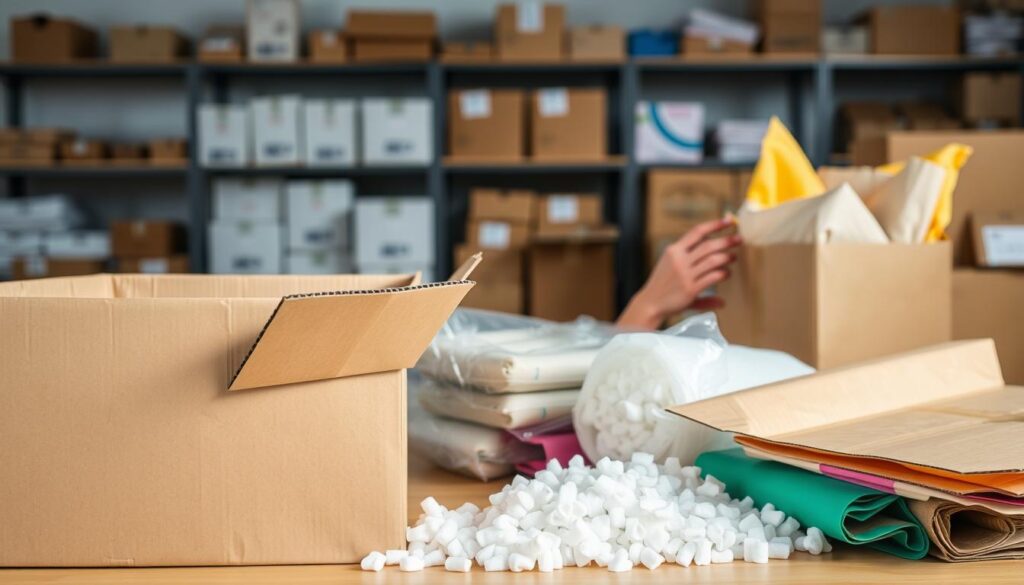Did you know that choosing the right types of shipping packages can ensure your products arrive safely? It’s true.
Choosing the correct packaging is key for safe delivery. With so many options, picking the right one can be tough.
The packaging you choose can greatly affect your product’s condition during shipping. A good package protects your item and improves the customer’s experience.
Key Takeaways
- Understanding the importance of choosing the right shipping package.
- Overview of different packaging materials available for shipping.
- Factors to consider when selecting shipping package types.
- Impact of packaging on product safety and delivery success.
- Best practices for packaging fragile or sensitive items.
The Importance of Choosing the Right Shipping Package
Choosing the right shipping package is key to keeping your items safe and ensuring they arrive on time. The right package protects your products and makes the delivery process smoother. It’s not just about safety; it’s also about making your customers happy.
Impact on Product Safety and Delivery Success
The right package is crucial for product safety and delivery success. It keeps your items safe from damage during shipping. For fragile items, the right materials and design can greatly reduce breakage risks. FedEx offers detailed guidelines on how to pack breakables, including tips on materials, cushioning, and labeling.
Also, a well-packaged item is more likely to arrive on schedule. This is because it’s less likely to get damaged, which can cause delays or returns.
Choosing the right package also shows you care about your brand. It means you’re committed to delivering your products in top condition. This can make your customers happier and more loyal, which is good for your business.
How Package Selection Affects Shipping Costs
Your package choice can also affect shipping costs. Bigger or heavier packages cost more to ship. So, picking a package that fits your item well can save you money.
Using the right packaging can also save on extra protective measures or repackaging. This can help cut down on costs.
Optimizing your package selection can make your shipping process easier. By choosing efficient packages, you can simplify your logistics. This can lead to lower shipping costs over time.
Types of Shipping Packages: An Overview
The world of shipping packages can seem overwhelming. But knowing the different types can help ensure your items arrive safely. Each type of packaging has its own benefits and is best for certain products.
Standard Cardboard Boxes
Standard cardboard boxes are a key part of shipping. They are versatile and affordable for many products. You can find them in various sizes to fit your needs.
When choosing a cardboard box, the construction matters. You’ll find single-wall and double-wall boxes.
Single-Wall vs. Double-Wall Construction
Single-wall boxes are good for lighter, less fragile items. Double-wall boxes, with two layers, offer more protection. They are better for heavier or more fragile items.
“Double-wall boxes provide added durability and protection,” says a packaging expert. “They reduce the risk of damage during shipping.”
Common Box Sizes and Their Uses
Cardboard boxes come in many standard sizes. Smaller boxes are great for shipping jewelry or small electronics. Larger boxes are for furniture or bulkier items.
Knowing the common sizes and their uses can help you optimize your packaging. It can also save you money on shipping.
Poly Mailers and Bubble Mailers
Poly mailers and bubble mailers are flexible and lightweight. They are perfect for shipping clothing, accessories, or small items that need extra cushioning. Poly mailers are durable, while bubble mailers have bubble lining for extra protection.
Both are water-resistant and easy to seal. They are a convenient option for shipping many types of products.
Rigid Mailers and Paperboard Envelopes
Rigid mailers and paperboard envelopes are for shipping items that need extra protection. They are great for jewelry, CDs, or small electronics. Rigid mailers are sturdy, while paperboard envelopes are more affordable and eco-friendly.
These mailers are ideal for shipping high-value or sensitive items. They provide extra care during transit.
Specialized Shipping Containers for Unique Items
The right shipping container is key for sending special items. These items might be fragile, need a certain temperature, or are very valuable. Standard packaging often can’t meet these needs. That’s where specialty shipping packages come in.
Tube Containers for Documents and Posters
Tube containers are perfect for documents, posters, and artwork. They protect long, rolled items from damage during shipping. You can find them in many sizes to fit different items.
Insulated Containers for Temperature-Sensitive Items
Some items, like medicines, biological samples, and certain foods, need insulated containers. These containers keep items at the right temperature during shipping. They often use cooling packs or heating elements.
Custom-Molded Packaging for High-Value Products
Custom-molded packaging is the best choice for very valuable or fragile items. It’s made to fit the item exactly, preventing movement during shipping. It’s great for electronics, luxury goods, and other valuable items.
Choosing the right specialized shipping container ensures your unique items arrive safely and in great shape.
Essential Packaging Materials for Secure Shipping
To prevent damage during transit, it’s essential to choose the right packaging materials. The right materials protect your products and make unboxing a positive experience for your customers.
Cushioning Materials: Bubble Wrap, Foam, and Air Pillows
Cushioning materials absorb shocks and prevent damage to your items during shipping. Bubble wrap is a popular choice for its versatility and effectiveness. For fragile items, foam inserts offer customized protection. Air pillows provide a lightweight, space-efficient way to cushion your products.
Void Fillers: Packing Peanuts and Paper
Void fillers fill empty spaces in packages, preventing items from moving during transit. Packing peanuts are a traditional choice, but paper fill is gaining popularity for being eco-friendly. Both options effectively fill voids and can be chosen based on your shipping needs and environmental concerns.
Securing Materials: Tapes, Straps, and Bands
Securing materials keep your packages closed and your items in place. Packaging tape is the most common choice, available in various widths and strengths. For heavier or larger packages, straps and bands offer additional security, ensuring your items stay safe during their journey.
| Material Type | Common Uses | Benefits |
|---|---|---|
| Cushioning Materials | Protecting fragile items | Shock absorption, customizable protection |
| Void Fillers | Filling empty spaces in packages | Prevents item movement, eco-friendly options available |
| Securing Materials | Keeping packages closed and items in place | Variety of strengths and widths, additional security for large packages |
How to Select the Perfect Package for Your Item
Choosing the right package is key to successful shipping. With many options, picking the best can be tough. But, by following a few steps, you can ship your items safely and efficiently.
Step1: Assess Your Item’s Fragility and Value
First, check how fragile and valuable your item is. Delicate or high-value items need strong packaging to avoid damage. Use custom-molded packaging or rigid mailers for these items. Knowing your item’s fragility helps you pick the right protection.
Step2: Consider Weight and Dimensions
Then, think about your item’s weight and size. Accurate measurements are key to picking a package that fits well. This reduces damage risk. Choose a package that’s the right size to avoid void space and item movement.
Step3: Evaluate Special Handling Requirements
Some items need special care, like refrigeration. If you’re shipping food or other perishables, check out our article on solutions for sending perishable food parcels.
Step4: Factor in Destination and Transit Time
Lastly, think about where your item is going and how long it’ll take to get there. Items going far or to hard-to-reach places might need stronger packaging or faster shipping. Knowing the shipping path and time helps you prepare your item right.
By following these steps, you can choose the best shipping package. This ensures your items arrive safely and on time.
Cost-Effective Strategies for Shipping Package Selection
To keep your shipping costs down, it’s key to use smart packaging strategies. Choosing the right package can cut your shipping costs a lot. This doesn’t mean you have to sacrifice the safety of your items.
Comparing Costs Across Package Types
Each package type has its own price tag. For example, big or heavy items often fit better in standard cardboard boxes. On the other hand, poly mailers are cheaper for smaller, lighter items. It’s important to look at the prices of different packages to find the best deal for your needs.
| Package Type | Cost per Unit | Suitability |
|---|---|---|
| Standard Cardboard Boxes | $0.50 – $2.00 | Large or heavy items |
| Poly Mailers | $0.25 – $1.00 | Small, light packages |
| Rigid Mailers | $0.75 – $3.00 | Fragile or high-value items |
When to Invest in Premium Packaging
It might seem smart to save money by choosing cheaper packaging. But, sometimes, premium packaging is worth the extra cost. This is especially true for valuable or fragile items. It helps ensure they arrive safely and keeps your customers happy.

Bulk Purchasing and Inventory Management
Buying packaging in bulk can also save you money. Plus, managing your inventory well means you always have what you need. This avoids the need for expensive, last-minute buys.
By using these smart strategies, you can make your shipping package choices more cost-effective. This helps lower your costs and makes your shipping process more efficient.
Eco-Friendly Shipping Package Options
Eco-friendly shipping packages are becoming the norm for businesses globally. As more people care about the planet, companies are switching to greener packaging. This change is a big step towards a more sustainable future.
Biodegradable and Compostable Packaging
Biodegradable and compostable materials are leading the way in eco-friendly packaging. These options break down naturally, lessening harm to the environment. Biodegradable packaging decomposes over time, and compostable packaging turns into compost.
Big names like Unilever and Patagonia are already using these materials. They’re making a big difference in reducing waste.
Recycled and Recyclable Materials
Using recycled and recyclable materials is key to eco-friendly shipping. Recyclable packaging can be reused, cutting down on waste and saving resources. Many companies are choosing packaging with post-consumer recycled content.
This choice not only cuts down on waste but also helps save natural resources. It’s a win-win for both the planet and businesses.
Minimalist Packaging Approaches
Minimalist packaging is another smart move for businesses. It means using less material and simplifying designs. This approach reduces waste and lowers shipping costs.
Amazon’s Frustration-Free Packaging is a prime example of this strategy. It shows how businesses can cut down on waste while keeping costs low.
By choosing eco-friendly shipping options, companies can help the planet. They also attract customers who care about the environment. It’s a win-win for everyone.
Step-by-Step Guide to Properly Package Items for Shipping
Properly packaging items for shipping is an art. It involves several key steps to ensure safe delivery. It’s not just about protecting your items. It’s also about making the shipping process smooth.
Let’s break down the packaging process into easy steps. This will help you see why each step is important for safe shipping.
Step1: Measure and Prepare Your Item
Start by measuring your item accurately. This will help you choose the right packaging material. Make sure your item is clean and dry to avoid damage during shipping. Remove any detachable parts to prevent loss or damage.
Step2: Select and Assemble the Appropriate Package
Choose packaging that fits your item’s needs. For fragile items, use sturdy boxes or padded mailers. For non-fragile items, a simple envelope might be enough. Follow the manufacturer’s instructions or your own experience to assemble the package.

Step3: Add Proper Cushioning and Protection
Cushioning is key to protect your items during shipping. Use bubble wrap, foam inserts, or packing peanuts to fill spaces and absorb shocks. Make sure your item can’t move inside the package.
Step4: Seal, Label, and Prepare for Transit
After packaging and cushioning, seal the package securely with packing tape. Label it clearly with the recipient’s address and any handling instructions (like “Fragile”). Prepare your package for transit by adding the right postage and completing customs forms.
By following these steps, you can ensure your items are well-packaged for shipping. This reduces damage risk and guarantees a successful delivery.
Conclusion: Making Informed Shipping Package Decisions
Exploring shipping packages shows how important smart choices are. Knowing about standard boxes, poly mailers, and special containers helps pick the right ones. This way, you can find the best options for your needs.
Choosing the right materials, like cushioning and void fillers, is key. Also, think about the weight, size, and special needs of your items. This ensures they get to their destination safely. Following this guide helps you make choices that protect your items, save money, and are good for the environment.
Smart shipping decisions can make customers happier, cut down on costs, and be better for the planet. Staying up-to-date with shipping and packaging trends helps improve your business. This way, you can reach your goals more easily.

